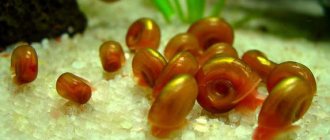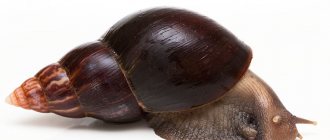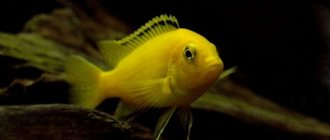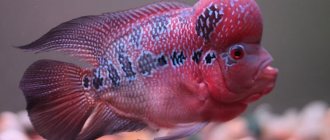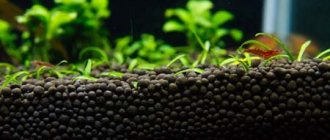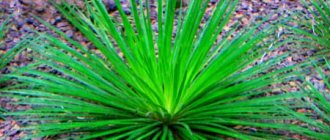Aquarium snails are beautiful, useful and for the most part do not harm other inhabitants. However, there are times when they reproduce so profusely that they begin to irritate the aquarist. This is especially true for ground snails, such as melania. Getting rid of them completely is not easy, and in this article we will look at the main ways to deal with an excess number of snails.
Types of snail control in an aquarium
Predatory snails – Helena
In my opinion, this is the most effective, safe and affordable method of fighting snails. Until recently, helens were not so easy to find, but now they are everywhere and cost pennies.
Carnivorous helena snails (Antentome helena) are carnivorous and eat other species of snails. In recent years they have become quite popular and buying them is not a problem. These are beautiful, cone-shaped snails that also look attractive. Grows up to 1.-2 cm.
Helenas can significantly reduce the number of snails and even completely exterminate them; if this happens, they begin to eat like all snails, although such a diet is not typical for them. Although they do not reproduce as quickly as regular snails, they are gradually crowding out all other snails.
Disadvantages of the method : none. Snails do not touch fish and shrimp, but they are very effective at destroying other snails.
Chemical methods
Snail control medications can be purchased from pet stores and online stores, but should only be used as a last resort as it has a lot of side effects. The main problem is that when it works, mass death of snails will upset the balance in aquarium.
Death will cause a bacterial outbreak, changes in water parameters and fish diseases. Moreover, the chemistry will not kill all snails and their eggs, and they will continue to reproduce by eating the remains of their relatives.
Disadvantages of the method . Read the instructions carefully, many preparations contain copper and are toxic to fish and shrimp, also avoid using other aquarium chemicals, they may reduce effectiveness.
Snail traps
Many brands now produce snail traps, but buying them is a controversial idea. It's easier to do it yourself. The most basic trap for snails is to leave a leaf of scalded cabbage overnight at the bottom of the aquarium, placing it in a jar. In the morning it will be covered with snails, which are easy to remove. By doing this regularly, you will significantly reduce the population.
If fish, for example, catfish, do not allow you to do this, then you can modernize the method. We take a plastic bottle, close it, burn or pierce holes in the bottom so that fish cannot get in and snails can easily get in.
Inside we put either lettuce, cabbage or other vegetables, preferably scalded, so they will work more efficiently. Fill the bottle and leave. In the morning you will receive a full bottle of snails.
Disadvantages of the method : low efficiency, slow process, decomposing vegetables can seriously cloud the water in the aquarium.
Fish
Some fish naturally eat snails and can be used to control them. However, if your fish is sufficiently full, it is unlikely to pay attention to them. Keep them slightly hungry.
An excellent snail eater is the tetradon, but it has a nasty temperament and is not suitable for community aquariums. Less aggressive ones include clown loach, macropod, and some types of gourami.
Also all types of catfish that eat snail eggs. To help the catfish in the fight, turn over the decor, driftwood, pots, etc., since caviar is most often deposited under it.
Disadvantages of the method : it is not suitable for everyone; fish that effectively eat snails are no less effective at eating other fish.
What and how to feed small snails
Under favorable conditions, snails reproduce, laying eggs once a month. If it is necessary to preserve the offspring, then it is better to remove all those who can eat the eggs. When babies are born, they are fully viable and need to be fed like adults. After two to three weeks, when they are stronger, you can put them into a common container.
With a separate aquarium for shellfish, nature will do everything itself. All that remains is to watch the birth of the offspring, and they will find food on their own and will eat what their parents eat.
These aquatic representatives are unpretentious and do not require special care. And they are very useful for their neighbors in the aquarium.
Snails in an aquarium
Snails are gastropods, part of the genus Mollusca, which also includes mussels and clams, and are characterized by a single shell. They move along the surface with the help of one large and muscular leg, eating food with a small mouth.
A pair of sensitive tentacles come out of the head and have eyes on them, with the help of which snails study the world. They have lungs to breathe on the surface, gills to breathe underwater, or both.
Most snails are hermaphrodites, that is, they have both male and female genital organs. In most cases, mating requires a pair to lay eggs in a protective mucous film; in an aquarium, they can often be seen under the leaves of plants.
Ampullaria lay a large number of eggs above the surface of the water, the clutch looks like yellow or orange eggs in a dense, hard heap. Some snails, such as aquarium melania, are viviparous.
Aquarium snails are omnivores; they can eat algae, food scraps, carrion, and rotting parts of plants. Some large snails can damage delicate plants, but contrary to popular belief, small snails do not damage them.
A controlled population of snails does not harm the aquarium; on the contrary, the snails eat leftover food, clean algae, and soil snails mix and aerate the soil, preventing it from rotting.
Many contain interesting snails - ampularia, which are not very demanding and are not prone to rapid reproduction. However, small snails such as physes and coils tend to multiply quickly in favorable conditions, and quickly fill the aquarium, covering glass, filters, and plants.
Prevention
As you already understand, removing snails from an aquarium is a thankless task. Therefore, it is necessary to prevent their penetration if possible.
Most snails sneak into the aquarium by traveling on store-bought plants. Their eggs are very small in size and are often difficult to notice. Therefore, it is a good idea to quarantine the purchased plant before placing it in the aquarium.
You can also wash purchased plants in potassium permanganate at a concentration of 10 milliliters per liter of water. You can keep the plants in this solution for 10 or 15 minutes, then rinse thoroughly with clean water. Some plants may be more sensitive than others; the procedure must be carried out carefully.
In conclusion I would like to add. If none of the above helped you completely get rid of snails, you can remove those that catch your eye, leaving the rest alone. Indeed, apart from their ability to spoil the appearance of the aquarium, they do not cause much harm. If their quantity is not excessive, they are unlikely to even spoil the plants. www.gambusia.ru
GD Star Rating loading…
How to get rid of snails., 4.2 out of 5 based on 19 ratings
How to avoid snails in your aquarium
Usually, snails enter a new aquarium in the form of eggs or adults, which are transferred along with plants, decor, or when transplanting fish. Check all plants for snails or their eggs, or soak plants in a solution that kills them (Hydra-Tox), even the most careful aquarists have snails.
For a balanced aquarium, snails do not pose a threat. Instead of fighting their penetration into the aquarium, it is better to monitor their number; rapid reproduction means some problems in the aquarium.
Fish and snails: friends or enemies?
Snails play the role of “aquarium orderlies”. After the death of an aquarium fish, snails immediately begin to eat it. However, they should not be allowed to do this. It is necessary to remove the dead fish from the aquarium immediately, without waiting for the snails to eat it. Otherwise, the water will inevitably become filled with nitrogen compounds. Snails are not able to eat live aquarium fish, as they are unable to catch up with them. At the same time, many aquarium fish willingly feast on live snails. These fish include gouramis, tetradons, and cichlids. Many aquarists breed snails to feed them to fish. This allows them to save money on food purchases.
Reasons for breeding snails in an aquarium
The main reason for an excessive number of snails in an aquarium is excessive feeding of fish. Snails devour leftover food and multiply in a quadratic progression. If you are worried about snails, or more precisely their number in the aquarium, check whether you are overfeeding the fish?
Typically, waste accumulates in the soil and serves as a storage area for snails, so the second task is to siphon the soil and remove any remaining food. Snails also eat algae, and if you don't have ancistrus or similar catfish, it's worth adding them to the jar, creating food competition. In addition, catfish eat snail eggs.
Turtle
Do turtles eat snails? In the diet of many species of turtles, mollusks are present on a regular basis. They do not refuse any aquarium inhabitants, including ampularia, neretina, melania, marise, etc. If the gastropod has a conical shell, you need to break off the tip, and then offer the mollusk to the turtle.
Snails are also grown to feed turtles, but under no circumstances should they be given mollusks from open bodies of water (meadows, pond snails). They accumulate a large amount of harmful substances in their bodies, and are also often intermediate hosts of certain types of parasites that can also live in turtles.
Myths about snails
Snails pollute the aquarium Quite the contrary, aquarium snails eat waste, clean surfaces, and destroy algae. This myth most likely stems from the fact that snails thrive in neglected aquariums that are overfed and poorly maintained.
Snails can kill small fish Snails are omnivores and will eat anything they can get their hands on. When the fish dies or is already very weakened, the snails instantly gather for a feast. The aquarist sees that the fish is lying on the bottom and is being eaten by snails, but they are not to blame for its death. With a little thought, it’s easy to understand that a slow-moving snail cannot pose any danger to healthy and playful fish.
Snails spoil plants Some snails, especially from nature and local water bodies, can damage plants. But the majority of aquarium snails do not harm plants in any way. Snails have small mouths adapted for scraping surfaces, while higher plants have a hard surface. The origin of the myth is easy to understand - snails constantly eat old, dying leaves and it seems that they are the ones who killed them.
How to control the population of aquarium snails:
- Don't overfeed
- Clean the soil regularly
- Get catfish or shrimp so that they also eat algae
- Get some fish that eat snails
- Turn over driftwood and decor
- Use snail traps
- 7. Check new plants and decor for eggs and snails
- Never use plants or decor from local bodies of water.
- Do not feed the fish for a couple of days, they will be more willing to eat snails
- Watch your water if you use chemicals
Arthropods
Crustaceans in the aquarium are kind of orderlies: they destroy the remains of food that has fallen to the bottom, and also pick up dead fish. If there are crayfish or shrimp in the container, you do not have to worry about removing the dead fish, unless their size is too large.
Crustaceans are fully responsible for the cleanliness of animal residues, but some types of shrimp actively eat algae, and those that are so annoying in cultural fish farming and plant growing.
Amano
The name in the Russian-speaking environment was given to this species by the famous Japanese aquarist, who introduced individuals for life in a home aquarium.
The real name is Caridina multidentata.
These shrimp grow up to 6 cm and love neutral or slightly acidic water of 23 - 26 degrees.
- With a sufficient number of specimens in the population (about 1 shrimp per liter, they are able to completely remove plaque in a short time). However, for this they must receive a minimum of food from outside.
- Therefore, in the combined “fish + shrimp” container, measures must be taken so that not a lot of food reaches the latter, otherwise the crustaceans will prefer tasty protein food to hard algae.
The Amano shrimp has gained universal love among landscapers, because it is in planted aquariums that an algal outbreak is most likely and at the same time undesirable. This type of shrimp effectively fights the hated thread.
Unfortunately, Amano breed reluctantly at home: salt water is needed for the development of larvae.
Neocaridins
These are dwarf shrimp native to Southeast Asia. They reach only 1 cm in length as adults, which does not prevent them from successfully feeding on lower algae without touching higher plants.
Neocaridins are ideally suited for breeding in mono-aquariums, that is, shrimp tanks for beginning aquarists. They are unpretentious, and it is quite easy for them to provide the necessary conditions. You just have to make sure that the concentrations of certain substances are kept within acceptable limits.
Some of the most dangerous compounds for shrimp are substances containing copper. But the advantage can be relatively easy reproduction under the right conditions - the population will quickly grow even without special measures.
